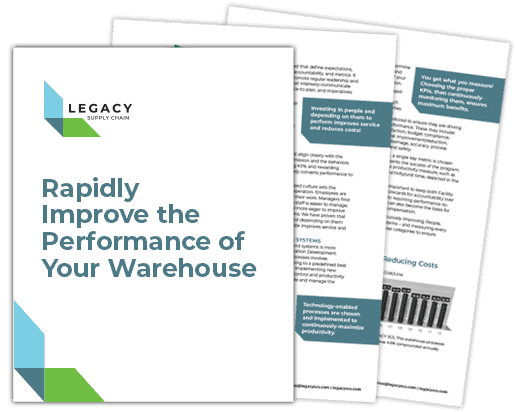The Ins & Outs of 3PLs: 7 Things to Look for in a 3PL Provider

Logistics are integral to the global supply chain. In light of heightened customer expectations, supply chain disruption, and the rising cost of doing business, it can be challenging for companies both large and small to manage every aspect of logistics on their own. Third-party logistics (3PL) helps solve this problem by outsourcing logistical operations and supply chain management to third-party providers — providers with established infrastructure and years of proven supply chain experience.
Keep reading to learn more about 3PL, including common 3PL services, how to choose the right 3PL provider and more.
Table of Contents
- Understanding 3PL Providers & Services
- 7 Reasons to Partner with a 3PL Provider
- Key Considerations When Choosing a 3PL Provider
- How to Find the Right 3PL for Your Business
- Partnering with a 3PL: 8 Tips for Success
Understanding 3PL Providers & Services
Any company that offers third-party logistics services to another organization is known as a 3PL provider or simply a 3PL. These providers offer a wide array of 3PL services, which generally belong to one of three categories:
Distribution
Distribution services broadly encompass any activity involved in the movement of goods from a central location, such as a warehouse or distribution center, to various destinations, including retail stores, consumers’ doorsteps and other points of sale. Common examples of distribution services include:
- Multi-client warehousing (or shared warehousing), a form of outsourced warehousing operations management in which multiple clients share a single warehouse space, with shared labor, technology and other supply chain infrastructure
- Dedicated warehousing (or contract warehousing), a form of outsourced warehousing operations management in which warehousing space, labor, and other operational infrastructure is dedicated to a single tenant
- Omni-channel distribution, a logistics approach that enables the efficient and synchronized management of inventory, fulfillment operation and delivery across multiple sales channels
Fulfillment
Fulfillment comprises a wide variety of services related to receiving and processing orders and preparing them for shipment to an end consumer, often in a direct-to-consumer eCommerce model. These 3PL services can include:
- Order management, which refers to the end-to-end process of receiving, processing, fulfilling and tracking customer orders
- Inventory management, which refers to the strategic control and optimization of inventory levels, including monitoring stock levels, forecasting demand and managing replenishment
- Transportation optimization, a strategy that leverages data analysis, route planning and load optimization techniques to enhance transportation efficiency and reduce operating costs
- Pick, pack and ship, an order fulfillment method in which workers pick individual items from warehouse shelves and package them for shipment onsite
- Kitting and assembly, an order fulfillment method in which various items — known as child components — are assembled and packaged together to create a kit in preparation for shipment
- Drop shipping, an order fulfillment method in which, rather than stocking product themselves, a merchant relies on the supplier or manufacturer to fulfill customer orders
- Last-mile delivery, also known as final mile delivery or final mile logistics, refers to the transportation of goods from a warehouse or distribution center to their final destination
- Returns management, which refers to the process of handling and processing customer returns, including inspecting, sorting, restocking and either selling or disposing of returned items
Transportation
Transportation services include any service involved in the coordination and movement of goods from one location to another. These services can include:
- Transportation brokerage, which refers to the process of facilitating and coordinating transportation services between shippers and carriers, generally by a transportation broker
- International transportation, or freight forwarding, which describes the movement of shipments across international borders, often using ocean cargo vessels or air cargo planes
- Dedicated cartage, or dedicated fleet services, in which a 3PL provider allocates and operates a fleet of vehicles or trucks for a specific client or purpose
Each of these services leverages a variety of transportation methods, including:
- Over-the-road (OTR) transportation, which describes the movement of shipments — often intercity or interstate — by road or highway using trucks or other motor vehicles
- Rail transportation, which describes the movement of shipments — again, often intercity or interstate — by freight train
- Intermodal transportation, also known as multimodal transportation, which refers to the use of multiple forms of transportation — OTR, rail, ocean and/or air — to move goods from one location to another
- Specialized transportation, which refers to the transportation of goods that require specialized handling, equipment or expertise, such as oversized or heavy cargo, hazardous materials, perishable goods or delicate items
- Just-in-time transportation, a logistics strategy that minimizes inventory holding costs by synchronizing transportation activities to align with production schedules and customer demand to ensure on-time arrival
- Drayage, which describes the short-distance transportation of goods, typically between a port or rail yard and a nearby warehouse or distribution center, using trucks or other transport vehicles
7 Reasons to Partner with a 3PL Provider
For companies looking to optimize order fulfillment and scalably grow their business, partnering with a third-party logistics provider is a smart bet. Here are just a few of the reasons why businesses should consider outsourcing logistics to a 3PL company:
- Readily Available Resources: Rather than start from scratch, partnering with a 3PL provider offers a company instant access to that provider’s existing infrastructure, technology, network, personnel and supply chain expertise. Generally speaking, the more years a 3PL company has been in business, the more proven its processes, the more extensive its network, and the stronger its relationships — something that most companies simply can’t replicate when handling order fulfillment on their own.
- Established Networks: Speaking of networks, 3PL providers often have access to established domestic and international networks, as well as entire teams of supply chain professionals with existing knowledge of international regulations, customs processes, documentation requirements and more, and that have experience operating in global markets. These existing networks and proven expertise can be valuable assets for businesses looking to expand their operations globally.
- Staffing Scalability: 3PL providers hire, train and retain their own staff, saving businesses the time and expense of establishing their own teams to support logistics operations. In many cases, 3PL companies can easily scale up their teams according to demand — a real asset in an industry known for its seasonality.
- Existing Expertise: Many of the people working for 3PL companies are seasoned supply chain professionals with years of experience helping clients create strategic plans to optimize order fulfillment, control costs, navigate supply chain disruption, mitigate risk and more.
- Advanced Technology: 3PL providers offer access to specialized technology, including warehouse management systems, transportation management systems, order tracking systems, advanced analytics, real-time reporting and dashboards. Many of these systems can seamlessly integrate with their clients’ core systems, allowing for an unparalleled level of visibility into logistics operations.
- Cost-savings: Outsourcing logistics to a 3PL can help businesses save money, as 3PL providers can offer volume-based discounts on last-mile delivery services — something their clients can’t achieve when fulfilling orders in-house and shipping direct through major parcel carriers.
- Complete Freedom: Without the need to carefully manage every aspect of order fulfillment in-house, companies that partner with 3PL providers have the freedom to focus on their core competencies — research and development, production, sales, marketing, customer service and so on — and on growing their business.
Key Considerations When Choosing a 3PL Provider
Finding the right 3PL provider can lead to a long list of benefits, but with 3PL companies in the market today, it can sometimes be difficult to determine what separates a “just fine” 3PL from one that’s truly great.
To ensure that you find a 3PL partner worth their salt, look for the following criteria:
- Proven Experience: Prioritize 3PL providers that have years — ideally, decades — of experience working with companies in your industry. Although newer 3PL companies may make bold claims, they often lack the robust infrastructure, years-long relationships and prior experience navigating supply chain complexities to truly meet your business’ needs. As a general rule, it’s best to ask to speak to companies from a 3PL provider’s existing customer base to get an accurate read on what it’s like to partner with that partner. If a 3PL denies this request, consider taking your business elsewhere.
- Scalable Capacity: Retailers, manufacturers, wholesalers, distributors and eCommerce companies are all subject to seasonal demand. In order to accommodate this demand, they require the ability to scale logistics up or down as needed. Bearing this in mind, it’s important to determine whether a 3PL provider has the capacity to meet not only your company’s current logistics needs but also your future needs should you experience a surge in demand or business growth.
- Competitive Costs: Logistics operations can be costly to manage, but whether it’s offering volume-based shipping discounts, negotiating favorable transportation rates through its network or optimizing costs through data analysis, the right 3PL should help your business lower your overall investment and meet your target cost structure.
- Industry Recognition: Awards aren’t everything, but they can be a helpful barometer when determining whether a potential 3PL partner is worth working with, as they demonstrate that a provider is respected within its industry. It’s also important to review a 3PL company’s licenses, certifications and memberships with various associations to assess how established it is in its industry and whether it has the proven expertise to support its claims.
- High Visibility: When outsourcing logistics to a 3PL provider, it’s imperative that you know where your shipments are every step of the way, regardless of whether they’re en route to your warehouse or a customer’s front doorstep. A truly qualified 3PL provider should leverage the latest technology — with integrations to your company’s internal systems — to provide total visibility, traceability, and transparency into all shipments.
- Value-added Services: Most 3PL companies offer the same general set of services — order fulfillment, warehousing, transportation and so on — but some go the extra mile by offering value-added services such as quality control and inspection, customized packaging and labeling, kitting and assembly and reverse logistics. To get the greatest return on your investment, look to providers that offer a full spectrum of 3PL services to meet any current and future needs.
- Positive Culture: A 3PL provider is only as good as its people — and the more engaged a 3PL’s workforce, the better results they’ll deliver for your company. When vetting potential providers, be sure to take company culture into account, looking for a 3PL partner that treats its employees with dignity and respect, offers them flexibility and empowers them to succeed.
How to Find the Right 3PL for Your Business
You know what a 3PL is, what services 3PL companies offer and what to look for in a 3PL provider — what’s next? Most businesses in the market for a 3PL partner start their search via referral or submitting a request for proposal (RFP).
Regardless of which approach you take, the general process for finding the right 3PL looks something like this:

1. Determine your business needs and goals. Before beginning your search, you’ll need a clear understanding of what 3PL services you require, including any specialized services, and what you hope to gain from the partnership. In doing so, you’ll be able to define more specific criteria for evaluating prospective providers.
2. Research potential providers. Using your business needs, objectives and the criteria you’ve defined as a baseline, create a shortlist of contenders that meet your requirements. Be sure to take customer reviews, referrals from trusted sources and 3PL companies’ industry reputations when creating your shortlist.
3. Submit RFPs to your top picks. If you need help putting together an RFP that actually attracts 3PL providers’ attention, we recommend reading our guide on crafting the perfect RFP.
4. Evaluate any proposals you receive. You’ll want to use the criteria you’ve defined, as well as the general guidelines outlined in the previous section of this article, when comparing potential 3PL partners and deciding which order they fall in.
5. Come to a decision. When making your final selection, remember that choosing a 3PL should be more like choosing a business partner than a service provider. While cost is an important factor, you’ll want to consider a 3PL provider in its entirety, as choosing a partner based solely on lowest cost can hurt you in the long run. A true partnership approach and mindset gives you the greatest chance of meeting your business’s present and future needs and achieving a significant ROI.
Partnering with a 3PL: 8 Tips for Success
Once you’ve selected a 3PL provider, there are a few simple measures you can take to get the most out of your partnership:
- Set clear expectations with your 3PL partner and maintain open lines of communication.
- Notify your 3PL partner of any changes to business requirements, forecasts or priorities as soon as possible.
- Establish key performance indicators early on in the relationship that you can use to gauge success.
- Continuously monitor your 3PL partner’s performance and take a proactive approach to raising issues or concerns.
- From holding joint planning sessions to sharing important information and forecasts in real time, work collaboratively with your 3PL provider to ensure strategic alignment.
- Be open-minded to new technologies and trends and open to discussions around process innovation and continuous improvement.
- Foster a culture of continuous improvement and innovation with your own internal teams.
- Take the time to familiarize yourself with your 3PL partner’s culture and attitude toward safety.
Find out firsthand why Legacy Supply Chain is one of the leading third-party logistics providers in the market today — contact us today to speak to a member of our team.
Learn how to improve warehouse performance and see real results with the insights found in our free, downloadable guide.

Get Insights. Stay Ahead.
Get the latest news and insights via email on warehouse improvement, transportation optimization, labor strikes and international shipping rate changes.Popular Posts
Search Posts
-
2024 Q1 Freight Landscape: Trends, Challenges, and Predictions
As the first quarter of 2024 comes to an end, here are some observations over the past few months as well as predictions about the trucking...
+ Read more -
Baltimore Bridge Impact Assessment – Update
Following the recent Baltimore Bridge collapse and subsequent port closures, we want to keep our customers informed about the situation and...
+ Read more -
Global Momentum Builds for Charge on Global Shipping Sector’s CO2 Emissions
A growing coalition of 47 countries, including key players like the European Union, Canada, Japan, and various Pacific Island nations, is...
+ Read more









